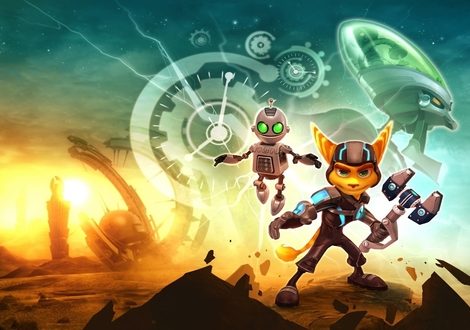
Legends of the Lombax: A Ratchet and Clank Retrospective – Part 1
The tale of PlayStation’s perennial favourite, Ratchet and Clank, is one that begins several Solana suns ago. If you will, dear readers, cast your mind back to the turn of the millennium. The year is 2000. Legendarily sleep-deficient developers Insomniac Games had just finished off work on Spyro: Year of the Dragon, the third instalment in the beloved platforming trilogy starring everyone’s favourite dashin’, skateboardin’, pop-culture referencin’ purple reptile, on the PS1.
They certainly weren’t wanting for attention. Critical praise had been heaped upon the Spyro games, with everyone from professional reviewers to little old ladies (yes, for real) writing in to the studio to tell the weary folks behind the titles how much they’d enjoyed their laidback pace and tight controls. Nor were they hurting for cash, as a lucrative deal with Universal had ensured their coffers would be lined for years to come with those sweet, sweet residuals. And yet! And yet. Despite all these successes, they had absolutely no clue how to head forward into the beckoning PS2 era. They knew platforming was their bread and butter, but having just churned out three pretty similar games, they were itching to try something a little different.
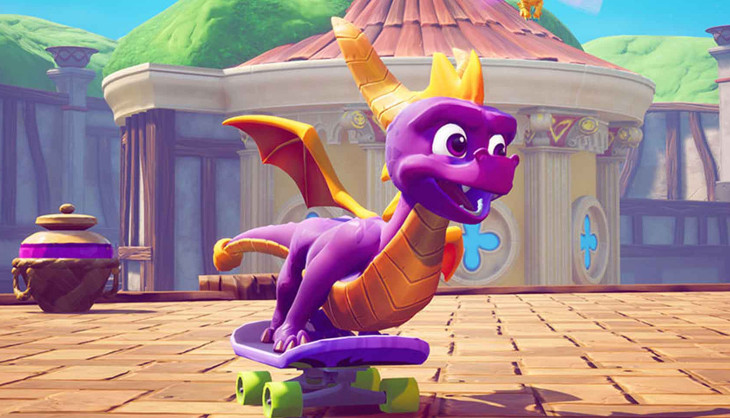
The first step, then, was coming up with an idea. Several were spitballed around the office: Monster Knight was one which never saw the light of day, and the hilariously on-the-nose Girl With a Stick (gee, I wonder what that would have been about?) was also trashed. Perhaps for the best. Things finally got moving when creative officer Brian Hasting floated the concept of “an alien that travels from planet to planet, collecting weapons and gadgets,” not to be confused with… well, any other of the numerous franchises that feature an alien that travels from planet to planet, collecting weapons and gadgets.
Still, the idea excited the team as it would give them the opportunity to design far wackier environments than they’d yet experimented with, not to mention the chance to get a little bit more sophisticated with their established brand of off-colour humour. Everything was in place. All they needed now were a couple of characters. Down sat the concept artists, and, following many rounds of caffeination, soon along came a little doodle of a feline-looking creature. He had a long tail, a self-assured smirk and, most importantly, a comically, needlessly large gun. “I think,” said his designer, “we’ll call him a Lombax.” Ratchet was born.
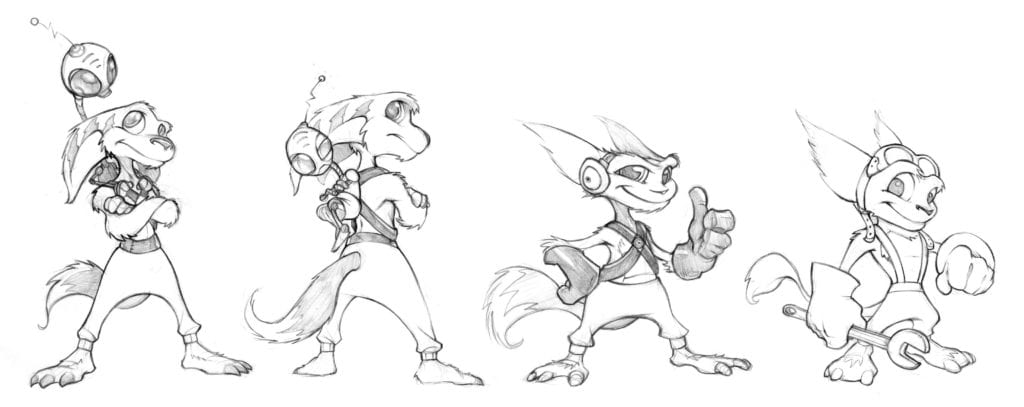
I don’t think you need me to tell you how the rest of the story goes (but I’m gonna have a darn good try at it). Here we are in 2021, and the Ratchet and Clank series is pushing twenty years and still going strong. While some of its Sony platforming bedfellows – hi Jak and Sly, bye Jak and Sly – have seemingly bit the dust for the time being, there’s never really been a time where there hasn’t been a title of some sort starring the duo on store shelves. It’s spanned a Veldin variety of games, crossed over into cinema, television and comic books, and has undeniably cemented itself into the zeitgeist of gaming culture. The cocky Lombax even got himself a namedrop in Avengers: Endgame. Now there’s famous for you.
So, with the pair’s latest outing, Rift Apart, hitting the PlayStation 5 (assuming of course anyone has been able to get one) in a few days’ time, we thought: what better moment to have a look back at the complete timeline of their adventures to date? We’ll have a look at what worked, what didn’t, and pontificate on what might happen in the new one. Just a wee heads-up first, though – herein be more spoilers than in a Formula One junkyard. But let’s be fair, the games have been out for yonks, you’ve had time to get through them if you care. Still, there’s your warning.
The series has more or less turned into a multi-layered, highly thematic sci-fi space opera since its inception as a goofy little buddy comedy, so if you’ve any desire to experience its multiple twists and turns ahead of Rift Apart for yourself, back out now. OK, everyone ashore who’s going ashore? Fantastic. Hang on to your nuts (and bolts) folks: this is part one of our dive into the saga of Ratchet and Clank.
Ratchet and Clank (2002)
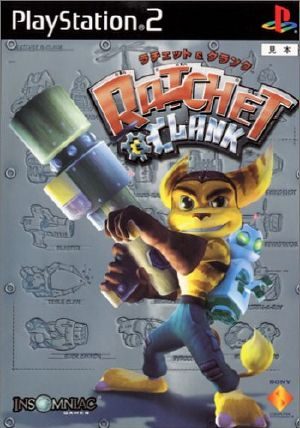
Here’s where it all started. The PS2 original, Ratchet and Clank, blasted onto the scene in 2002. For a while, it was inescapable, with Sony throwing the full weight of its marketing force behind it; huge ads plastered across magazines, TV spots and even subway billboards. Luckily, the game itself more than lived up to the hype.
Plot-wise, what would soon become a galaxy-spanning epic started off in total mundanity. We open on the barren desert planet of Veldin, home to the enterprising young Ratchet, who was left there as a baby by unknown parents. The Skywalker parallels come thick and fast. He’s sick of his simple life as a tinkerer, and has been working on a starship to try and leave, but he’s missing a crucial part – an ignition system. So basically, he’s plumb out of luck.
Meanwhile, on a distant planet, the corrupt Chairman Drek is building a warbot army as part of a diabolical scheme. But thanks to a wayward bolt of lightning, the production line briefly malfunctions and spits out a defective robot. He’s tiny, weak, and not particularly impressive, but he’s got smarts. Instantly developing a conscience, the little fella swipes evidence of Drek’s plot and flees in an escape pod, before crashing on Veldin where, much like Harry and Sally did that one time, he meets Ratchet. Of course, at this point he still doesn’t have a name, other than his serial number (B54296. See, I know things!) so Ratchet gives him one: Clank, after the noise he makes when he moves. It’s a pretty sweet moment.
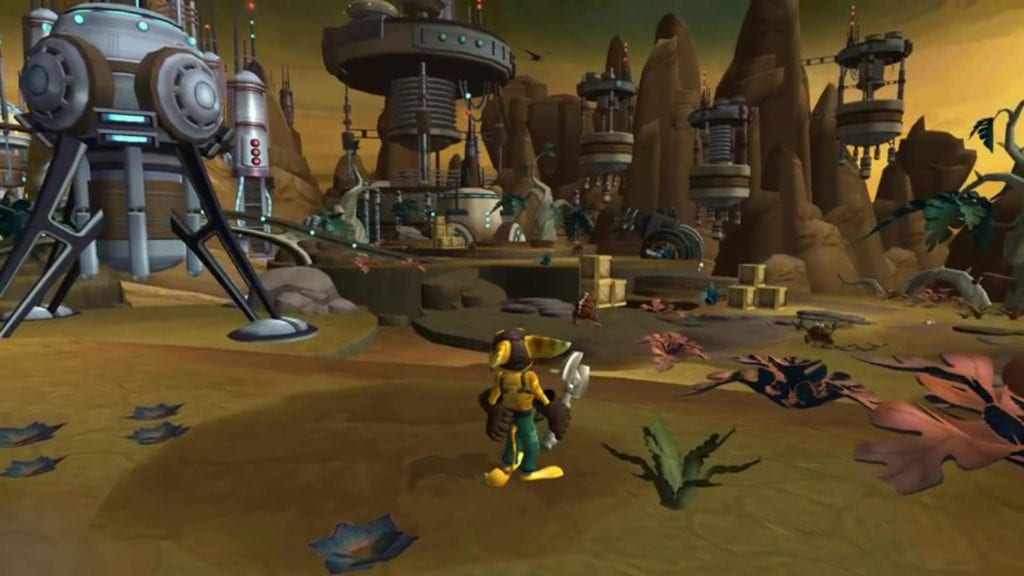
After a bit of bickering, Clank agrees to act as a robotic ignition system for Ratchet’s ship if he’ll agree to help him stop Drek; who, it turns out, is planning to nuke every planet in the Solana galaxy and use the pieces to build a new homeworld for his people, the Blarg, after his factories rendered their old one uninhabitable. If you’re perceptive, you just might be picking up on a bit of social commentary there. We’ll get to that, but yes, you’d be right. And so Ratchet and Clank are off on their maiden voyage together, and hey, in a way, so are we along with them.
The fluidity of the gameplay style that the original Ratchet and Clank pioneered cannot be overstated. While all the trappings of 3D platformers are present, correct and done extremely well – bottomless chasms, collectibles in the form of bolts, light puzzle sections – the major focus is on combat and the absurdity of the tools with which you administer said whuppings. To begin with, you’re armed with the bare essentials. Your trusty omniwrench can be used for up-close thwacks or powerful throws, and you also have a basic bomb glove to chuck explosives at Drek’s mooks.
But they’re not really what we’re here for. Once you’ve gathered enough currency, you can trade it in at the local Gadgetron store, run by a guy who looks and sounds like King K. Rool’s mob boss cousin, for some proper weapons. These range from a simple machine gun called the Blaster to ridiculous creations like the Chicken-izing Morph-o-Ray and the Suck Cannon which, as the name implies, vacuumed up enemies with all the gusto of Luigi turned loose on the set of Paranormal Activity. The ultimate goal for many players was to save up enough bolts for the RYNO, or the Rip You A New One. No prizes for guessing what that little number did. It wasn’t cheap, costing well over a million, but boy did it break the game.

No matter your choice of weapon though, there was a visceral pleasure to be found in hopping through these varied worlds, laying waste to everything in your path with ease. Things only got better as you unlocked jet packs and aqua packs, allowing for air and water-based battles too, as well as a strafing ability which would be expanded on in later instalments. Brief puzzle bits where you play solely as Clank broke up the explosive action with some more cerebral gameplay, allowing you to hypnotise mini bots to do your (often suicidal) bidding. You won’t be missed, Clank Slave #72.
But where this game, and all the others that followed, really shone was in its characterisation and tone. Unlike the cheery, sickeningly twee world that Spyro inhabited (at least until everything went a bit Lord of the Rings with 2005’s The Legend of Spyro, right down to the dragon being played by Elijah Wood) the Solana galaxy was a cynical, bitter, snarky place.
Almost everyone you met was out to profit off you or others in some capacity. Around every corner was a Gadgetron billboard or an ad of sports star Skidd McMarx (good one guys, real mature) hawking some kind of in-universe product. NPCs would not give you information without money, the most egregious example being a scientist you rescue from Drek’s fleet who then won’t share his invention until you fork over the dough. There’s gratitude. Al, a local robot repairman, similarly refused to fix Clank until you crossed his palm with a few bolts. Recurring gag character The Plumber is abandoned on his planet amid an alien invasion because the rich people have taken all the escape ships. “How come you were left behind?” asks Clank. “Socioeconomic disparity,” he replies. Harsh.
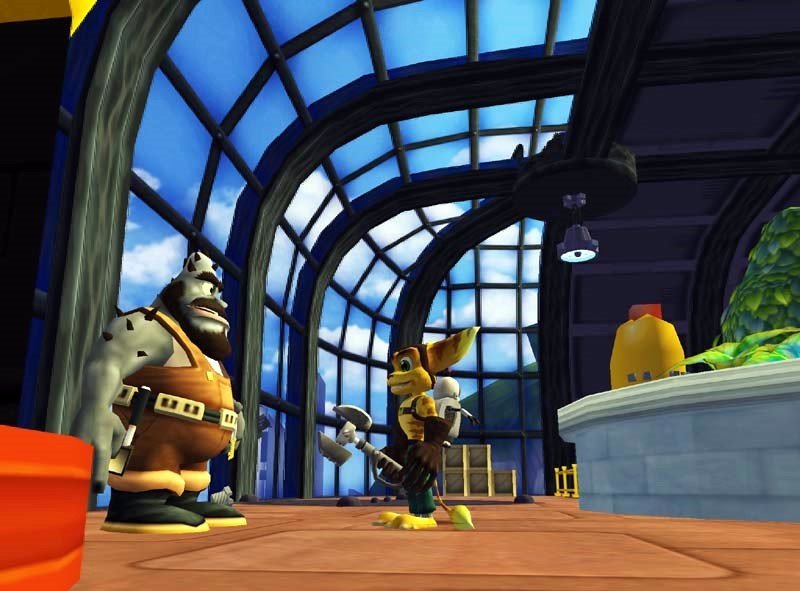
The capitalistic themes are perhaps best exemplified in the characters of Drek and Captain Quark, his dogsbody. It’s revealed in the grand finale that Drek polluted the Blargian homeworld on purpose to force its citizens to buy land on the new planet he’s building, after which he’ll pollute that one as well and repeat the scheme ad nauseum, becoming filthy rich. That’s a great twist in that it upends everything you thought you knew about Drek, turning him from a generic, Tarkin-esque marauder into a conniving, politician-like figure. The real-world comparisons are painfully easy to draw, too.
Quark, meanwhile, is an outwardly buff and confident television personality who in reality is a sniveling coward, working under Drek with the promise of ongoing sponsorship deals. He spins yarns about foes he’s vanquished and grand adventures he’s been on, but it becomes clear as the games progress and he slowly becomes a bumbling ally to Ratchet that it’s all a load of tosh. It’s telling that, for all his self-aggrandizement, the last time we see him in this game is as a washed-up sales clerk calling himself Steve. My condolences to any Steves out there, by the way.
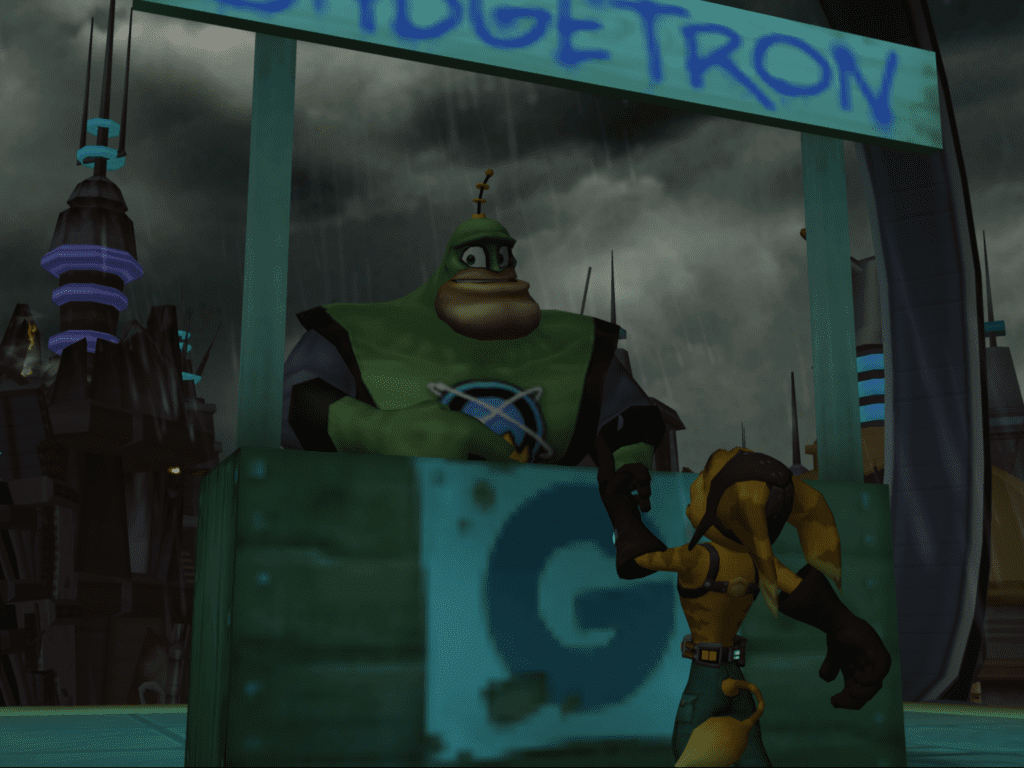
Even Ratchet himself is a bit of a jerk to Clank throughout, and the two don’t really warm up to each other until the very end. The dynamic really, really works: one who’s spent way too long stuck in an awful galaxy to really trust anyone, and the other having literally only been born yesterday, naïve to people’s tricks and falling afoul of traps as a result. But as the pair come through ordeal after ordeal, you get a sense they’ve become firm friends, and by the time they walk off together into the sunset after Drek’s defeat at the hands of his own Deplanetizer, it feels earned.
All told, the first Ratchet and Clank was a success in every sense of the word, laying a firm foundation for an ever-expanding universe that felt alive and, crucially, had a realistic edge to it. Gamers were enamoured instantly, and Insomniac had another hit on their hands. Unlike Chairman Drek’s stocks, things would only go up from here.
Ratchet and Clank: Going Commando (2003)
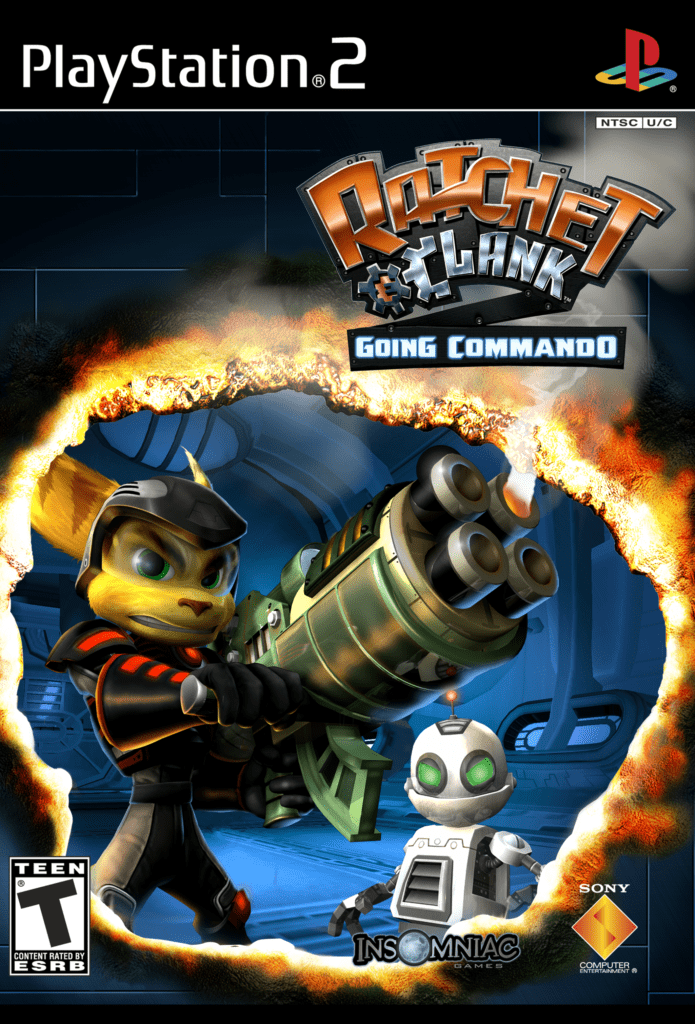
One year later we got the inevitable sequel, Going Commando, kicking off the series tradition of having a slightly naughty subtitle for each game. A little too naughty for us prudes in the UK, apparently, as it was renamed Locked and Loaded over here, with a similar treatment being applied to some of the other later games. Come on, fellas. We did Monty Python and Little Britain. We’re no strangers to a tad of innuendo.
Though Going Commando largely stuck to the original’s formula, there was more confidence on display this time as Insomniac began to hit their groove. Strafing during combat was now a basic ability, as was side-flipping to dodge incoming attacks, a total game-changer which made the clunky jetpack-based strafing of the original look positively primitive. Ratchet could now level up his health with EXP – such boosts being previously locked behind money gates – and upgrade his weapons with enough use. That’s right, with sufficient blasting, you too can turn your Lava Gun into a… better Lava Gun. I’m not sure how you could improve on shooting literal magma, but they found a way. Hotter magma? Who knows? All of this proved useful in the awesome new arena mode they added, which offered up a variety of addictive scenarios for you to gun your way through.
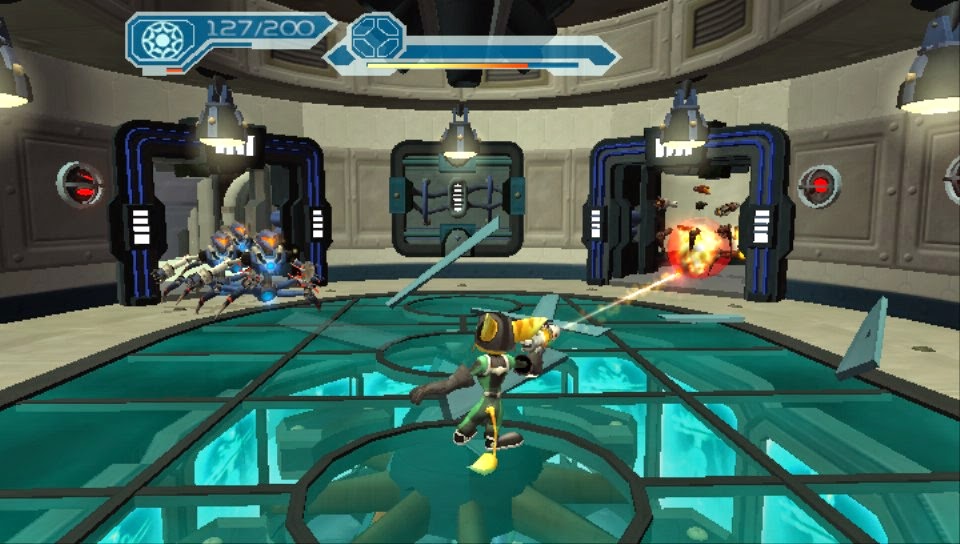
Plot-wise, more ambition was on show here too. We shifted locations to the Bogon galaxy, having been hired by Abercrombie Fizzwidget (curiously voiced by the same guy who plays Captain Quark, I’m sure that doesn’t mean anything) to retrieve an item stolen from him by ‘Thugs 4 Less’. Thugs 4 Less, a mercenaries-for-hire outfit, are just… a genius creation. They’re absolutely hysterical as villains go, ruthless but adherent to rules and a strict schedule. They’ll occasionally moan that you’re making them late for meetings as you decimate them, and we see video calls between them where they celebrate colleagues’ birthdays and complain that they’ve had their lunch nicked from the office fridge. They may be killers, but they keep bureaucratic order, dangit!
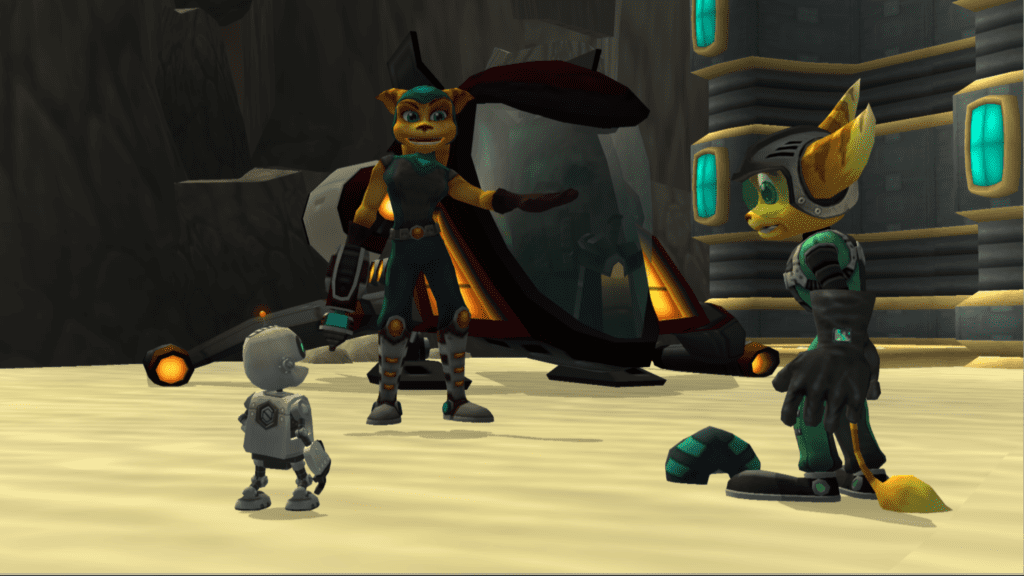
Elsewhere, Ratchet meets fellow Lombax Angela Cross who’s in deep trying to blow the lid off the Fizzwidget conspiracy. She’s the first Lombax he’s met in decades, setting up the plot thread of him discovering he might not be as alone in the galaxy as he thinks, and that there might be more to his and Clank’s meeting than he realised. Eventually, it’s uncovered that Fizzwidget is Qwark (gee whiz, what a shocker) who’s trying to regain public admiration by selling an adorable Protopet to all the kids of Bogon, despite the fact the fluffy things transform into vicious killing machines when you’re not looking. The duo finish off business in Bogon, Angela pushes off to take care of herself, Bob’s your uncle. A simple story, but one which bridges nicely into what many consider the best entry in the franchise.
Ratchet and Clank: Up Your Arsenal (2004)
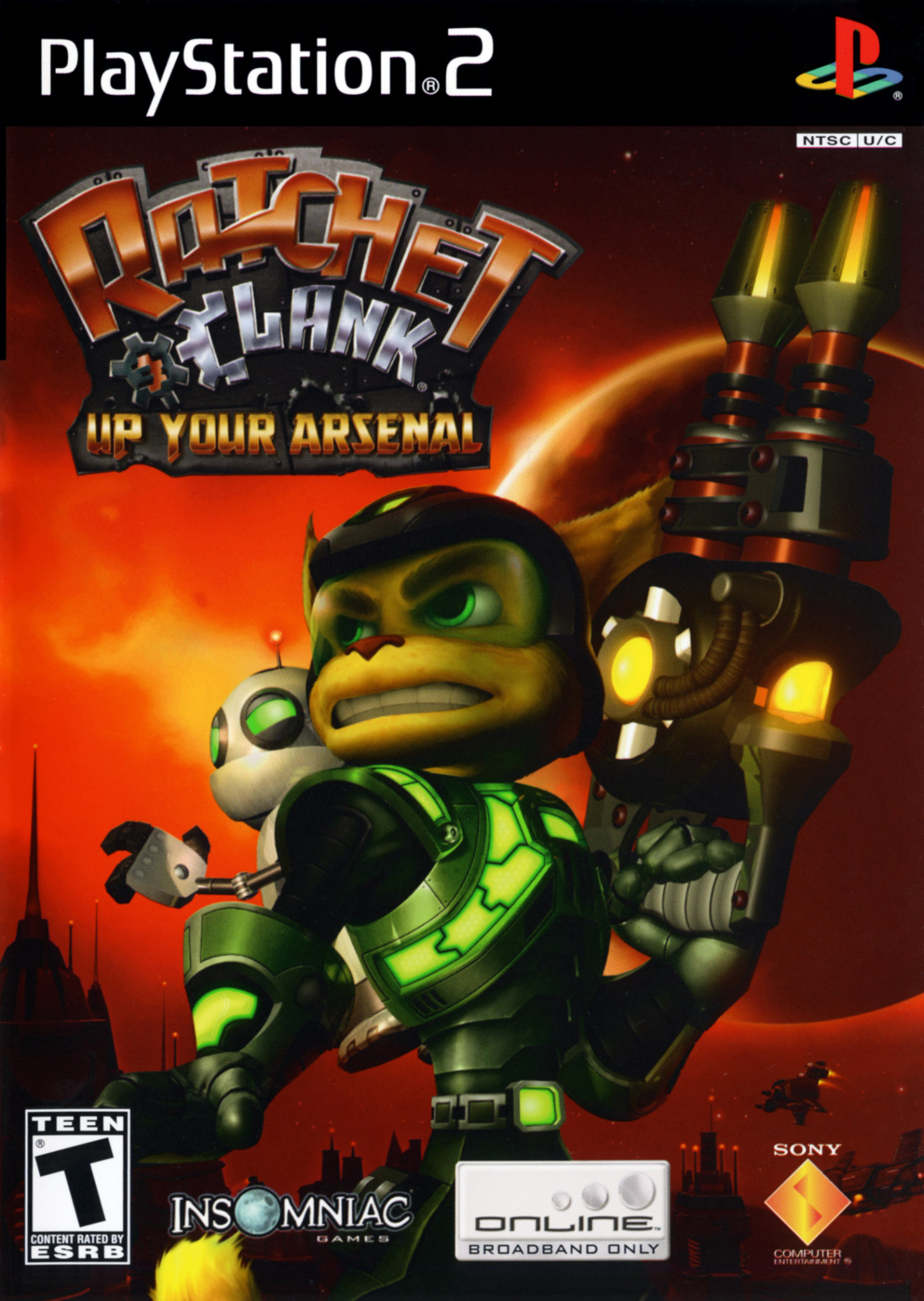
2004’s Up Your Arsenal – OK, now that I read that, I can kind of see what PEGI was worried about – represents the pinnacle of the classic Ratchet formula. Everything that had come before was tighter and more refined here, and very little that was new was added, so much so that I’ve not much to say on the gameplay front. There was a greater focus on a segmented, mission-style structure here. For the first time, a central hub acted as your base of operations where you could chill, hang out with the various NPCs you met over the course of the adventure, test your weapons and more before you committed to a level. There were even a few 2D platforming challenges to take on where you played as Quark, which filled in a bit more of his (largely falsified) backstory.
Once you were off on a mission, you reached your destination via dropship and actually got to skydive down to the battlefield, which, trust me, never got old. Arenas were better, boss fights were better, even the weapons were better – a favourite of mine being the Plasma Whip, which you could twirl and even chuck Indiana Jones style. It was just an all-around good time.
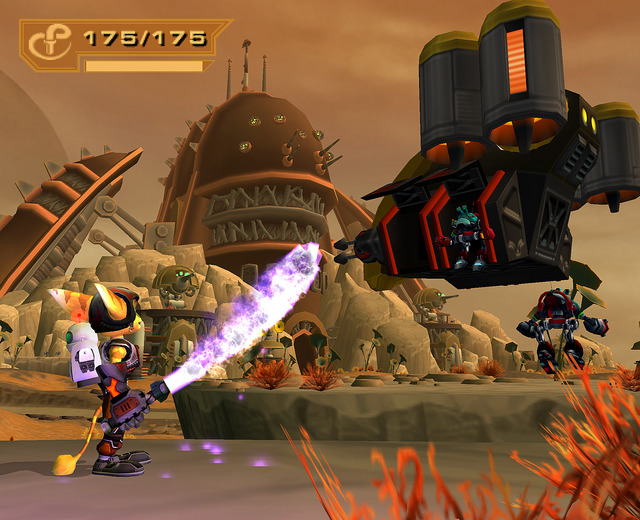
Up Your Arsenal’s biggest contribution to the franchise was in its introduction of mainstay villain Dr. Nefarious, but before we even get to him, we need to talk about the third game’s story. Put simply, it was bonkers. There was so much going on here, with multitudinous absurd plot points crammed into the space of the 15-hour adventure.
Let me try and recap this without losing you all: Ratchet and Clank join the Galactic Rangers, a sort of intergalactic police force. Clank is now a television star called ‘Secret Agent Clank’, with Ratchet playing his butler. Qwark has gone crazy and thinks he’s a monkey. Ratchet has a love affair with the President’s daughter, Sasha. A robot popstar named Courtney Gears produces a lewd music video intended to incite robot violence against organics. Clank is kidnapped and replaced with an evil clone, Klunk. Skidd McMarx returns and is roboticised. And finally, aforementioned new villain Dr. Nefarious wants to obliterate all biological life with his, erm, Biobliterator. You catch all that?

Yes, this one was positively bursting at the seams with ludicrousness, but that’s what made it so unique and charming. You never knew what insane turn things were going to take from stage to stage – would you be turned into Giant Clank and lay waste to a film set, or explore the innards of a Leviathan where you find Qwark crossdressing as a nurse? And Nefarious… oh man, Nefarious. There’s a reason why they keep bringing this guy back. Egotistical, hammy but woefully inept, he steals the show with his antics. He’s like a proto Dr. Doofenshmirtz, some years before Dr. Doofenshmirtz was even a thing. “We’ll see who’s insane when I’ve exterminated all life on this miserable planet,” he cackles without a trace of irony. “That should clear things right up, sir,” replies his sardonic, long-suffering butler Lawrence.
Nefarious is also a former alien turned robot who isn’t quite used to his mechanical body yet, and it’s prone to malfunctioning, tuning into a radio soap-opera on occasion called Lance and Janice. It features a… questionable romantic pairing. “Oh, Lance,” cries Janice, “we can’t, it’s not right. You’re my cousin’s uncle’s son!” I’m, uh… gonna let you do the math on that one.
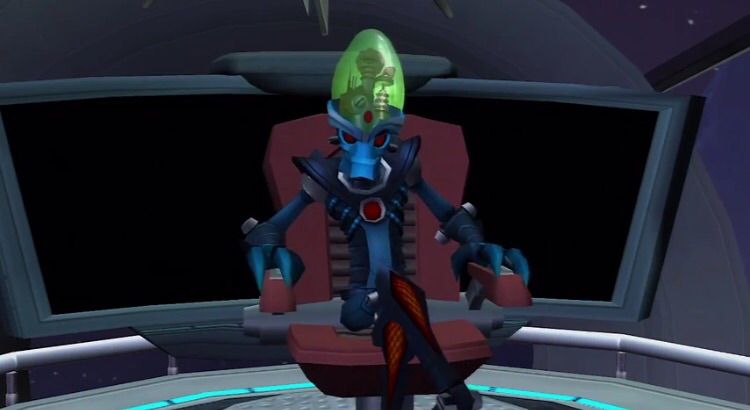
This attitude toward more risqué humour, perhaps in keeping with the outrageously bawdy title for the third outing, pervaded throughout the rest of the adventure. Local spiv Slim Cognito immediately opens with “I swear, the kid looked eighteen!” when you catch him off guard. The President tells Ratchet that Sasha “said you were good with your hands,” to which Ratchet retorts, “sir, I would never!” Qwark at one point even shills something called a ‘Crotchitizer’, and Clank remarks that it’s ‘still warm.’ Ew.
All told, Up Your Arsenal was the game in which the formula peaked. With top-notch gameplay, worldbuilding, storytelling and humour, the series could quite easily have packed it in there and then and I doubt many would have minded. Insomniac had wrung just about all they could from this particular well – or so it seemed. The next Ratchet and Clank adventure would shake things up dramatically.
Ratchet: Deadlocked (2005)
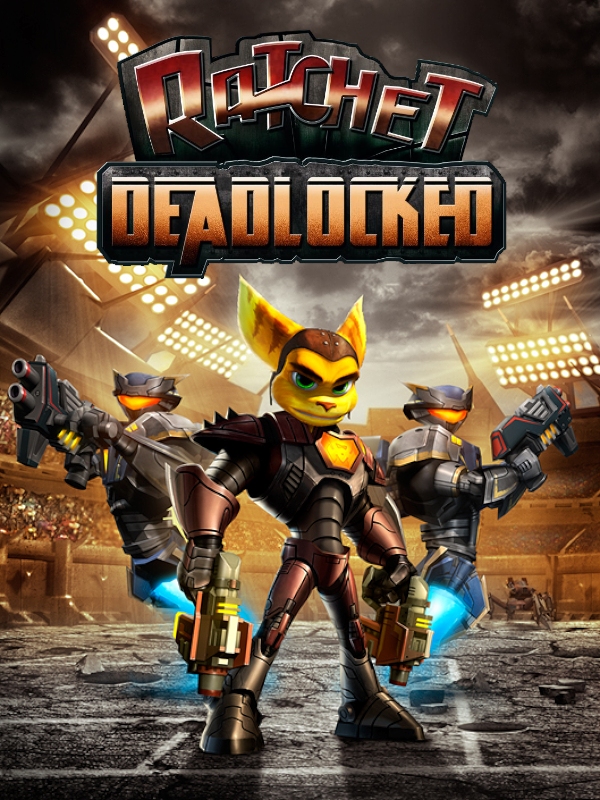
The dour, grimdark feel of Ratchet: Deadlocked represented a turning point for the thus-far lighthearted franchise. While nothing before or after it quite matched its tone and bleak worldview, it still had a knock-on effect on later games in that from this point on, things generally felt a bit more real. No longer were megalomaniacal galaxy-wide threats things to poke fun at; Ratchet was serious business now, baby.
Want a prime example of how much Deadlocked reinvented the Omniwheel? Clank isn’t even in most of this one. Instead, he sits on the sidelines watching as Ratchet is captured and forcibly conscripted into a televised battle to the death, run by the dangerous Gleeman Vox. Anchor for Vox News, natch.
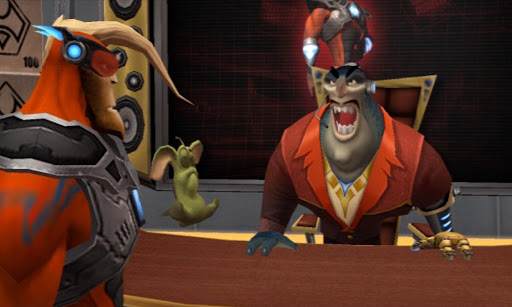
The rules of this game are made very clear. If Ratchet loses, he dies. If he forfeits, he dies. Hell, even if he wins, he might still die if Vox feels like it. A sense of total dread and urgency persists throughout the game, which has all but nixed any platforming, puzzling or really any sense of freedom. The only thing you’re doing is battling, battling and battling some more. There’s no downtime, no variety, no escape. Imagine the arena modes from the previous titles, except that’s the sole gameplay style and if you slip up once, you’re mercilessly gunned down by other terrified ‘contestants’.
Everything is designed to sell you on the idea you are helpless in this claustrophobic situation. The hub is purposely restrictive, there’s no roaming exploration of any kind – you can’t go anywhere without armed guards, after all – and previous NPC favourites like Al drop like flies with alarming regularity. The healthy dose of capitalistic cynicism that so defined earlier titles is doubled down on to the Nth degree in Deadlocked, with Vox offering Ratchet endorsement deals and merchandising if he’ll only agree to a lifetime of enslavement. Really though, what’s the difference at the end of the day?
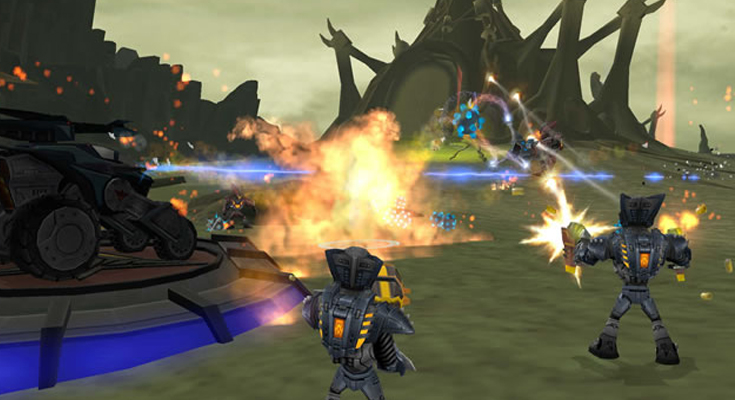
Understandably, a lot of folks were alienated by this screeching left turn into edgier territory, and one could be forgiven for comparing Deadlocked to such projects from the time period as Shadow the Hedgehog and Twilight Princess. There was a desire in the mid-2000s for previously family-friendly IPs to distance themselves from the veneer of squeaky cleanliness, as 90s gamers that had grown up with them were maturing.
Mixed results often ensued, and it’s telling that the next Ratchet outing, Tools of Destruction, made an immediate course-correction back to the classic setup. Still, Deadlocked has its fans, with some considering its combat to be the best we ever got out of the PS2 titles. Me? I can appreciate what it was doing, kind of like The Last Jedi, but I’m glad it didn’t become the default template. Also kind of like The Last Jedi. Huh. More Star Wars comparisons so far than I envisioned.
That brings us to the end of part one of our Ratchet and Clank retrospective. This closes out the PS2 era of the games, and we hope you enjoyed it! Look out for part 2 in advance of the release of Rift Apart, which will get you all nice and caught up for the new adventure!
Any thoughts on the series or on our piece? Let us know below!

